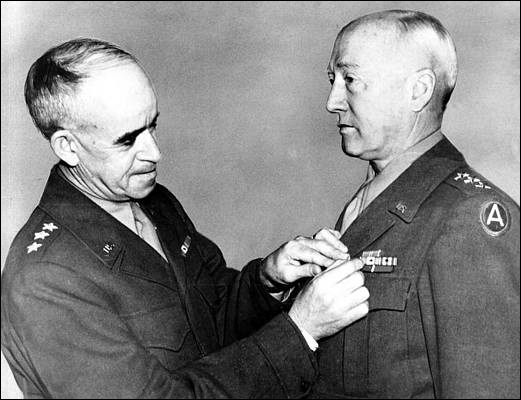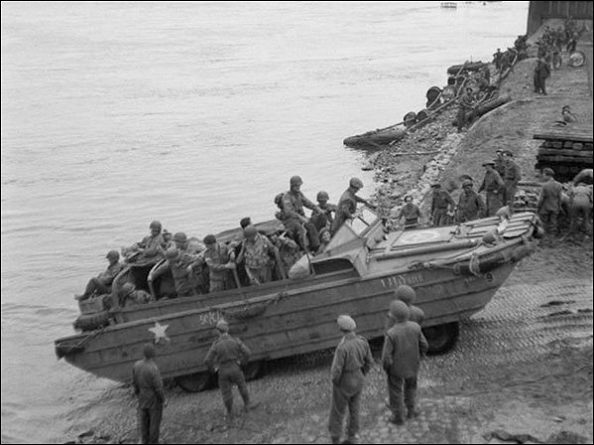● ● ●
NOTE ON NOMENCLATURE
The following terms are used in
this article: AAA (antiaircraft artillery), CIC (Counter
Intelligence Corps), CONUS (Continental United States), ETO
(European Theater of Operations), FA (Field Artillery), GHQ
Army (General Headquarters, United States Army), MP
(Military Police), NG (National Guard), PTO (Pacific Theater
of Operations), RA (Regular Army), TD (tank destroyer).
● ● ●
As was the case with most armies of
the World War II era, in the US Army the division was the
largest unit with a fixed organization. Higher echelons of
command—the corps, the field army and the army group—were
headquarters elements to which lower-echelon units were
attached as required. Thus a corps embodied a variable
number of divisions, a field army embodied a variable number
of corps, and an army group embodied a variable number of
field armies. Corps and field armies were also allotted
non-divisional combat support and combat service support
units: mechanized cavalry groups, FA groups, engineer
battalions, quartermaster and medical assets, etc.
At the time of America's entry into
the war, the bulk of the Army was located in the continental
United States (CONUS). The major overseas forces were in
Alaska, Hawaii and the Philippines, with smaller deployments
in the Caribbean, Iceland and elsewhere. The top command was
GHQ Army, which controlled the four geographical field
armies and defense commands into which CONUS was divided,
plus the Alaskan and Caribbean Defense Commands. The
Hawaiian Department and US Army Forces in the Far East
(Philippines) came directly under the War Department.
Each CONUS defense command was the
responsibility of a field army whose commander “wore two
hats” as the commander of both the army and the defense
command—though the latter were shadow organizations prior to
the outbreak of war on 7 December 1941. In addition, the
Armored Force, located at Fork Knox, Kentucky, controlled
the Army’s armored units: five armored divisions and a
number of separate armored battalions under the 1st Tank
Group. The Armored Force was classified as a field
army-echelon command.
The field armies controlled the
combat, combat support and combat service support units
located in their areas: one to three corps and an array of
non-divisional units. For instance First Army, headquartered
at Fort Jay, New York, controlled three corps with eight
infantry divisions, the usual support units, plus the
Coast Artillery Districts within the Northeastern Defense
Command. Each corps controlled one to four infantry
divisions. VIII Corps of Third
Army, for instance, controlled three infantry divisions: the
2nd of the RA and the 36th and 45th of the NG—all of the
latter by this time having been inducted into federal
service. Also under command were an FA brigade, a cavalry
regiment (horse & mechanized), an engineer regiment and
other units.
Though it prefigured the future
structure of the wartime Army, this initial organization was
not tactical or operational. Units were attached to the army
and corps headquarters for administrative and training
purposes only. The RA 3rd Infantry Division, for example,
was assigned to IX Corps, Fourth Army, and was stationed at
Fort Lewis, Washington. When war came, however, it went not
to the PTO with IX Corps but to the ETO, where it served in
Tunisia, Sicily, Italy, France and Germany. Of the four
field armies, only two, the First and Third, served overseas
in the ETO; the Second and Fourth remained in CONUS with the
primary mission of organizing and training newly raised
divisions and other units. The geographical defense commands
remained in existence, though they underwent some
organizational and name changes.

General Mark W. Clark, commanding
15th Army Group, and his army commanders
Lieutenant General Lucian K. Truscott (US Fifth
Army) and Lieutenant-General Sir Richard
McCreery (British Eighth Army) meet German
officers to arrange for the surrender of German
troops in Italy and western Austria, May 1945. (US Army Center
of Military History)
During the war three army group
headquarters were activated: Sixth (southern France),
Twelfth (originally First; northwest Europe) and Fifteenth
(Italy). Twelfth Army Group, commanded by General Omar N.
Bradley, was the largest of them—indeed the largest force
that the US Army has ever mustered. At the end of the war it
had four field armies under command: First, Third, Ninth and
Fifteenth. The armies controlled a total of twelve corps and
46 armored, infantry and airborne divisions. Fifteenth Army
Group had the distinction of being the Army’s most polyglot
higher command. In 1945 it embodied the US Fifth Army and
the British Eighth Army, including divisions and brigades
from the US, Britain, Canada, New Zealand, South Africa,
India, Poland, Brazil and Greece, plus various formations of
the Italian Co-Belligerent Army. Sixth Army Group embodied
the US Seventh Army and the French First Army, initially for
the invasion of southern France.
Corps,
field army and army group headquarters embodied a general
staff section supervised by a chief of staff who was the
commander’s principal assistant. The general staff section
was divided into four subsections: G-1 (personnel), G-2
(intelligence), G-3 (operations and training) and G-4
(logistics). During the war some armies acquired a G-5
subsection for civil affairs and military government. In
addition there were special sections for the technical
branches: ordnance, chemical, medical, adjutant general
(administration), judge advocate general (legal), inspector
general, etc. All these general staff and special sections
were supervised by a field-grade officer who in the case of
the G1-G5 sections bore the title assistant chief of staff.
As required there were naval, air force and allied armed
forces liaison officers attached to the headquarters. At the
army group level some staff positions might be held by
allied officers, as was the case with Fifteenth Army Group.
Army group, field army and corps
headquarters had a special troops battalion to provide the
necessary supply, transportation, signal and security
support. For a corps, this battalion typically consisted of
the corps headquarters company, a signal battalion, a CIC
detachment and an MP platoon. Corps also had a corps
artillery headquarters to control attached FA units. The
special troops battalions of field armies and army groups
were similar but usually included a quartermaster car
company to provide transportation for the staff, and one or
two MP battalions instead of just a platoon. All other units
appearing in the order of battle of these headquarters at
any given time were attached, i.e. not permanently assigned.
The attachment process was
facilitated by the group organization that the Army adopted
in 1943 for all branches but Infantry. Instead of regiments
and brigades with a fixed structure, branches such as the FA
and the Quartermaster Corps had small group headquarters to
which battalions and companies could be attached according
to mission requirements. For example, the 471st
Quartermaster Group attached to First Army on 6 June 1944
controlled five quartermaster battalions with a total of
fifteen truck companies and four gas supply companies.
Unlike the
German Army, which
designated some of its corps and field armies as Panzer
(armored) or Gebirgsjäger (mountain light infantry)
the US Army designated them by numbers only—by military
convention using Roman numerals for corps and spelled-out
numbers for field armies, e.g. VIII Corps, Fifth
Army. And whereas the German Army designated its army groups
by letters or geography, the US Army used spelled-out
numbers. Early in the war the Army did have two armored
corps, I and II, the former of which saw action in North
Africa until being reorganized and upgraded to Seventh Army.
The II Armored Corps never saw action as such. When it was
decided that armored corps were unnecessary it was redesignated as XVIII Corps and finally XVIII Airborne
Corps, thus becoming the only US Army corps with a type
designation.
Corps organization for combat was
very flexible, depending on the assigned mission and
available resources. A corps could control up to
five divisions, though two or three was the usual number,
and they could be
infantry and/or armored. The corps
artillery headquarters could be allotted up to five
FA
groups plus independent FA battalions and an FA observation
battalion. The groups themselves embodied a variable number
of battalions: usually two or three but occasionally as many
as five. Also under corps control was a
mechanized cavalry
reconnaissance group and, usually, a
TD group and an armored
group. Occasionally an AAA group was present also. Combat
engineer and service assets were attached either as groups
or independent battalions and companies.

Lieutenant General Omar
N. Bradley, commanding US Twelfth Army Group, presents
Lieutenant General George S. Patton, Jr., with a second
oak leaf cluster to his Army Distinguished Service
Medal. Visible on Patton's sleeve is the insignia of US
Third Army (War Department)
As a tactical headquarters the
corps was primarily concerned with fighting the battle.
Logistics was mainly the responsibility of the field army,
to which most service units were attached: quartermaster
truck companies, gas supply companies and service (labor)
companies; ordnance (maintenance and ammunition supply)
units; medical units; signal and signal construction units;
postal units and a variety of formations dealing with such
missions as psychological warfare, prisoner of war
interrogation, captured enemy documents, etc. Combat units
were also attached at field army level, typically a
mechanized cavalry reconnaissance group, an AAA group and a
TD or armored group.
For that most complex operation of
war, the amphibious assault, the corps was augmented with a
range of specialized units. On 6 June 1944, V Corps of First
Army, charged with the D-Day landings on Omaha Beach, had
two engineer special brigades a port operation group and a
special engineer task force under command. These formations
embodied combat engineer battalions, a large number of
quartermaster truck companies equipped with either regular
trucks or the DUKW amphibious truck, quartermaster service
battalions, signal units, two battalion-sized Naval Beach
Parties, and no fewer than nineteen Naval Combat Demolition
Units. Broadly speaking, their task was to organize a
logistical base in the beachheads seized on the first day of
the invasion, facilitating the reception and distribution of
supplies, personnel replacements and reserves. After the
breakout from Normandy, these units were taken over by the
Zone of Communications, European Theater (COMZ), a multi-echelon
organization with broad responsibility for logistical
support of the field armies. It must be admitted that this
sharp division of responsibility for logistics did not always work
smoothly: There was frequent disagreement and feuding
between the senior field commanders and COMZ over the
allocation of resources. However, the system worked well
enough to provide the US Army with a wide margin of material
superiority over then enemy—sufficient to assure victory.

A DUKW of a US Army quartermaster truck
company (amphibious) (US War Department)
With the end of the war, many
higher-echelon units of the Army were inactivated or
relegated to reserve status. But the basic organizational
template, division/corps/field army, was maintained and it
survived until the end of the Cold War and beyond. Only with
the recent reorganization of the Army on the basis of
self-contained modular combat brigades did it pass into
history. Even today, however, some modern Army commands
maintain the identity of the World War II-era armies and
corps, for example United States Army Central Command/Third
Army.
● ● ●